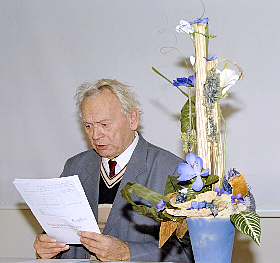Mäetagused vol. 61
Summary
-
 Ülo Tedre
Ülo Tedre
Mare Kõiva
The 61st issue of journal Mäetagused is dedicated to Ülo Tedre (February 12, 1928 - March 9, 2015), one of the most versatile Estonian folklorists, giving today’s readers and researchers an overview of his scholarly work in different fields of folklore.
Ülo Tedre was born in Tallinn on February 12, 1928, into a schoolteachers’ family. After finishing Tallinn Secondary School No. 7 in 1946, he continued his studies at the University of Tartu, and graduated in 1951 as an Estonian philologist, specialising in folklore. He considered the latter a field closest to history, yet also stressed its connections with linguistics. His degree studies were also related to folklore, with an interest in rhymed folksongs and parallel spread of oral and written forms of folksongs. He worked in the folklore section of the Institute of Estonian Language and Literature in 1949-1999, in the years 1962-1991 as head of the section, and the following ten years as senior researcher of the Department of Folkloristics.
Ülo Tedre’s scholarly work covered different song cultures and styles (runo song, newer song forms), studies of folk customs and especially masking, as well as the history of folkloristics. His legacy is comprised of more than 400 written, compiled and edited works, which cover practically all folklore genres as well as Estonian literary and cultural history, such as Eesti mees ja tema sugu (Estonian Man and His Kin) (1952-1954/2003), the four-volume Estonian folk song anthology (1969-1972), a short monograph Eesti pulmad (Estonian Weddings) (1973), a beautiful album to celebrate Jakob Hurt’s 150th birth anniversary (1989), the song collections of Jõhvi and Iisaku parishes in the series Vana Kannel (Old Zither) (1999), a voluminous overview of Estonian mumming and masking traditions published in Sweden (2007), to name but a few. In addition, he published a number of shorter writings about the Estonian runo song, beliefs and practices, and about Estonian folklore classics Jakob Hurt, Matthias Johann Eisen, Oskar Loorits, and Walter Anderson, as well as reviews of Estonian folklore in different collections and school textbooks, and more than 70 reviews on folkloristics, literature, and culture.
This special issue gives an overview of Ülo Tedre’s shorter writings concerned with different fields of folklore.
The article about masking is dedicated to the masking traditions of the autumn and winter periods, starting with Michaelmas and ending with mumming at the end of the year.
The next article discusses Estonian mumming traditions at Christmastime: their spread, age and gender of the participants, costumes and masking, communication between the hosting family and the mummers, and the gifts given to the mummers.
The third writing is a discussion held by Ülo Tedre, Enn Ernits, Mikk Sarv, Madis Kõiv, Vello Lõugas, Tõnis Vint, Ants Viires, Ülo Stöör, and Heino Eelsalu about colours, numbers, and shapes in our ancestors’ worldview.
The article about the runic verse in general and Vepsian runic verse in particular weighs the reasons why the Veps and especially southern Estonians preserved their song material, yet could not achieve the form of the runic verse.
The following article provides an overview of the Estonians’ everyday customs related to departures and being on the way, paying someone a visit, cooking, eating, and clearing the table. These customs also include new, urban, and international material, known in many countries and by different nationalities. The article about great changes in the Estonian folksong speaks about the emergence of the rhymed song in the 19th century, analysing the reasons why the older folksong started to fade and was replaced by the strophic end rhyme folksong.
The next article discusses the 19th century as the period of great changes in Estonian folklore, which laid a foundation for folkloristics. The 19th century was characterised by the quick receding and even fading of folk culture; on the other hand, prerequisites emerged for extensive collecting of folklore and establishing foundations for national culture.
The subheading of the article about M.J. Eisen’s road to folkloristics reads: From the Ancestors’ Treasures to the Riddles of Estonian Folk. Eisen’s bibliography is comprised of 761 items, written between the ages of 19 and 77. The article follows the path of the versatile writer to folklore and his first steps in the field of folkloristics.
The article under the heading, What Oskar Loorits and Other Learned Estonian Men Thought about Estonians’ Character, provides an overview of the estimations of Estonians given, starting from older historical records, to the viewpoints expressed by several cultural figures and experts on folklore, such as Loorits and Masing.
The following writing is dedicated to the Institute of Estonian Language and Literature against the world level. Ülo Tedre and Rein Veidemann try to find an answer to why folklorists write monographs and not articles required by the academic system.
A retrospective look at the work of the folklore section of the Institute of Estonian Language and Literature in 1947-1990 introduces the main directions in the work of the section, its publications, and international cooperation.